Putnam Park Wildflower Walk
A self-guided wildflower walk along the Putnam Park trail

Gladys Kampen Webb walking through Putnam Park. Illustration by Annmarie Geniusz.
The Wildflower Walk was made possible through generous gifts to the UW-Eau Claire Foundation. It was inspired by the memory of Gladys Kampen Webb, who enjoyed these blooms until she was 101. She loved locating and identifying the first spring flowers and sharing her knowledge with others.
UW-Eau Claire assistant professor of biology Dr. Nora Mitchell worked with the donor and a student to come up with a list of species to focus on. She then commissioned the local/regional Ojibwe artist Annmarie Geniusz to illustrate the flowers. After two years of work, the signage is up in Putnam Park and ready for all to enjoy.
Signage in Putnam Park
Bellwort
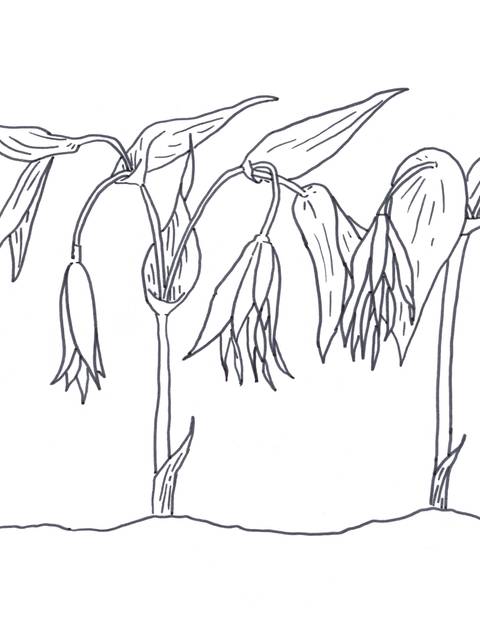
Scientific Name: Uvularia grandiflora
Family Name: Colchicaceae
Ojibwe Name: wezaawaabigwan+iig
Bellwort grows to 20 inches tall and is a rhizomatous herbaceous perennial. Blooming in early spring, it is one of the first wildflowers to emerge. Bellwort produces large, yellow, bell-shaped, pendant flowers. The top of the plant tends to bend downward due to the weight of the leaves and flowers. The hanging flower (1-1 1⁄2 inches long) is made up of both showy petals and sepals. This combination is referred to as tepals. Tepals of Bellwort can often look twisted. Bellwort can be found across most the eastern US and into Canada.
Learn more about the Bellwort on Consortium of Midwest Herbaria.
Bloodroot
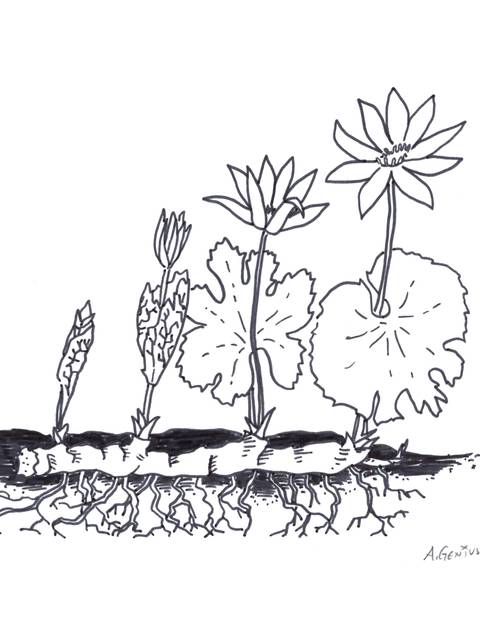
Scientific Name: Sanguinaria canadensis
Family Name: Papaveraceae
Ojibwe Name: Miskojiibik, Meskwijiibikak
This showy spring flower is found across deciduous forests throughout much of North America. Bloodroot is a small plant not growing much taller than 12-14 inches. It flowers in the spring, typically around March and April, and flowers extend above the leaves approximately 6-10 inches from the ground. The flowers are 1-1 1⁄2 inches across and have 8-10 white petals. The single distinct leaf of this plant arises from a thick horizontal rhizome that has a deep red colored sap which is where the common name comes from. Red juices obtained from the stem have been used by for dyes.
Learn more about the Bloodroot on Consortium of Midwest Herbaria.
Blue Cohosh
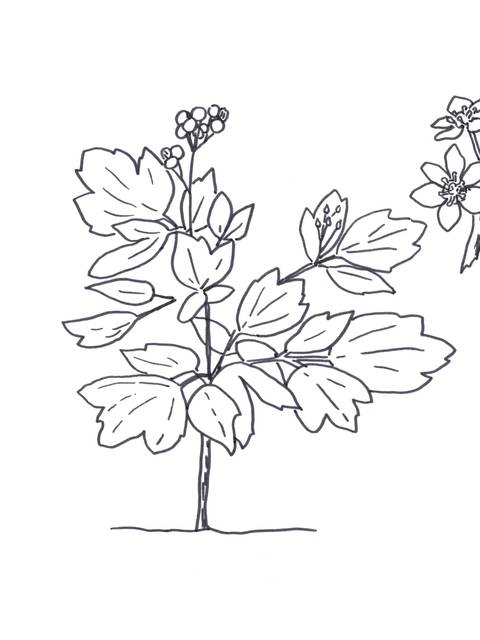
Scientific Name: Caulophyllum thalictroides
Family Name: Berberidaceae
Blue Cohosh is a spreading and bushy many-stemmed perennial that grows to be 1-3 feet tall. It has compound leaves with three lobed leaflets that are purplish in spring. Purple-brown to yellow-green flowers are formed in a loosely branched cluster at the branching “Y” of the stem in spring. The stamens and pistil of the flower mature at different times, ensuring cross pollination. The flowers are pollinated by non-colony forming (solitary) bees. Flowers develop into bright blue berries that may be toxic (DO NOT EAT). Berries begin forming immediately after flowering.
Learn more about the Blue Cohosh on Consortium of Midwest Herbaria.
Dutchman’s Breeches
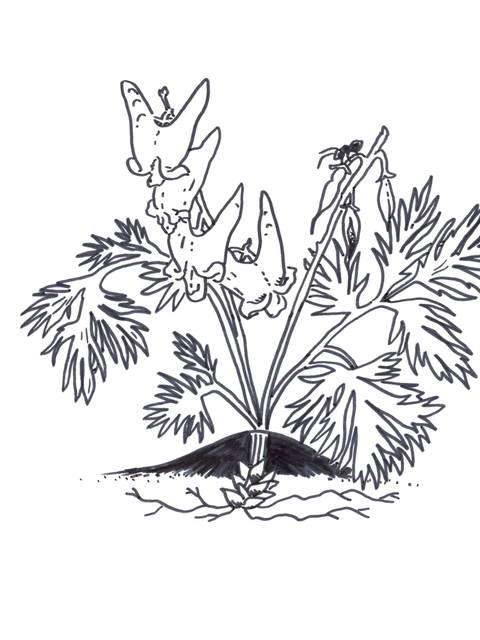
Scientific Name: Dicentra cucullaria
Family Name: Papaveraceae
Dutchman’s Breeches are a part of the family Papaveraceae which is informally known as the “poppy family.” The plant can be found throughout most of the Eastern Half of the United States and into Canada. Dutchman’s Breeches blooms in the early spring from March to April. Its flowers can range from white to pink and resemble a pair of pantaloons hanging upside down. The flowers are found on the ends of bare stalks that lead to clusters of the flowers. The plant usually grows to be roughly one foot tall. Being in the poppy family, Dutchman’s Breeches also contains small amounts of narcotic and toxic substances that cause “drunken” behavior in cattle that graze on them. This has led them to also being nicknamed “Little Blue Staggers.”
Learn more about Dutchman's Breeches on Consortium of Midwest Herbaria.
Early Meadow-Rue
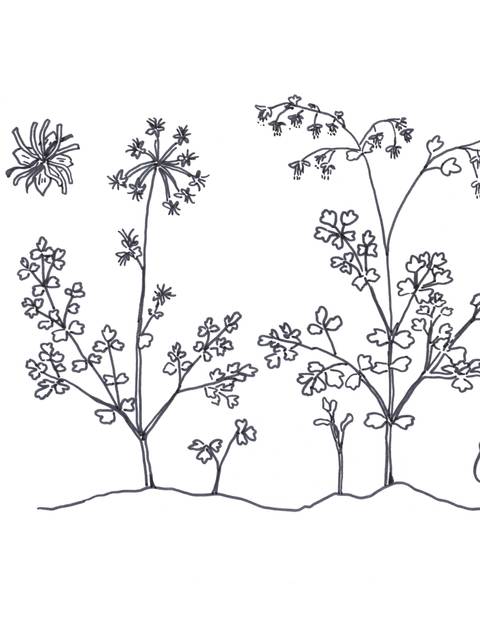
Scientific Name: Thalictrum dioicum
Family Name: Ranunculaceae
Early Meadow-Rue is an 8–28 inch perennial in the Buttercup family (Ranunculaceae) with long-stalked leaves divided into many delicate lobed segments. It is found across Wisconsin and does well in moist rich soils and on slopes. Early Meadow-Rue typically flowers around the time when trees begin leafing out. Male and female flowers are found on separate plants. The male flowers are petal-less, and instead have yellow stamens that hang like tassels. Female flowers are petal-less and have up to 10 thick white to greenish pistils. Flowers are found at the end of long stalks in males and in clusters on the stem in females. Clusters of dry seeds form on the female plants. The species name is derived from the Greek word “two households” which alludes to the fact that male and female flowers are on separate plants.
Learn more about the Early Meadow-Rue on Consortium of Midwest Herbaria.
False Rue Anemone
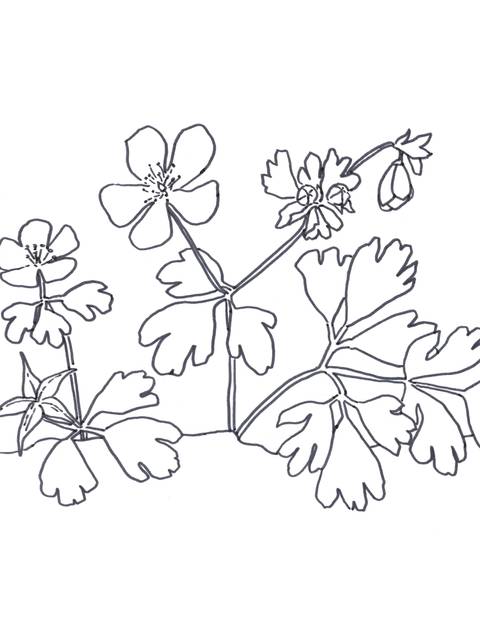
Scientific Name: Enemion biternatum
Family Name: Ranunculaceae
False Rue Anemone is a part of the buttercup family (Ranunculaceae). It is a perennial plant that grows to nearly 1 foot tall. The stems of the plant are reddish-green, hairless, and small. White flowers are found on the plant either individually or in groups of 2-3. Each flower is roughly 3/4 inches across with white petals and yellow anthers. False rue anemone often forms dense colonies of plants and can be established either clonally or by seeds. The fruit is a star-shaped cluster of 4-6 capsules. False Rue Anemone is found throughout Wisconsin and is common in rich deciduous woodlands and along streams. False rue anemone is one of the earliest spring bloomers and can be found flowering as early as April.
Learn more about the False Rue Anemone on Consortium of Midwest Herbaria.
Jack-in-the-pulpit
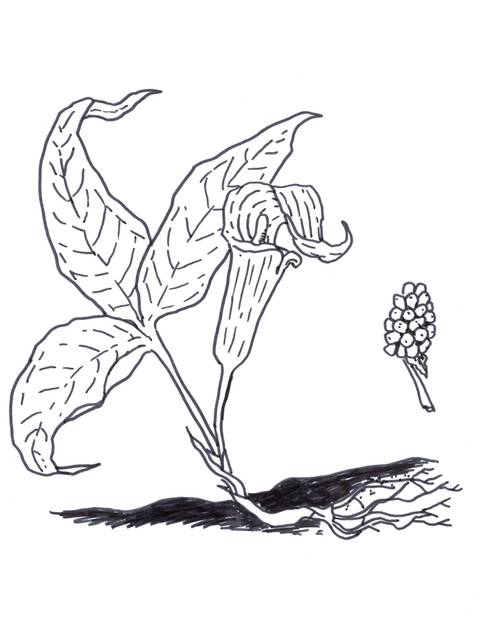
Scientific Name: Arisaema triphyllum
Family Name: Araceae
Jack-in-the-pulpit is a part of the Araceae family, which includes many species that posses clusters of multiple flowers (inflorescences). The reproductive structure of Jack-in-the-pulpit is formed by a green and maroon striped spathe surrounding a fleshy spadix that contains many tiny, embedded flowers. Jack-in-the-pulpit is pollinated by small flies and flowers from April to June. In the fall, female plants produce a stalk that contains red berries. These red berries, while pretty, will irritate the skin if touched and burn one’s mouth if eaten. The plant grows to be 1-3 feet tall and is a native perennial herb found in the woodlands of eastern North America. The single inflorescence produced is usually topped by two compound leaves of three leaflets each.
Learn more about the Jack-in-the-pulpit on Consortium of Midwest Herbaria.
Poison Ivy
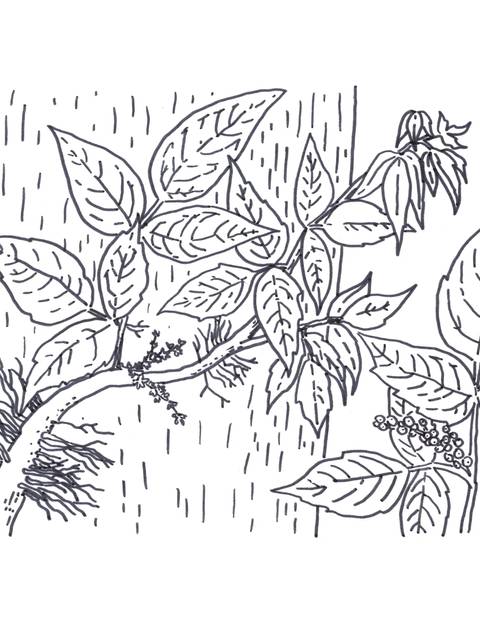
Scientific Name: Toxicodendron radicans
Family Name: Anacardiaceae
Ojibwe Name: maji-mashkos+iin
TOXIC — DO NOT TOUCH
Poison Ivy is a common plant throughout Wisconsin and causes rashes when touched. Rashes develop in response to urushiol oils found in the plant. If you touch this plant quickly washing off the area with soap and water can help prevent a reaction. Poison ivy is identified by its distinctive leaves. Each leaf has 3 glossy leaflets with smooth or toothed edges (up to 6 inches long and 4 inches wide). Leaves can vary, an old saying “leaves of 3, let it be” is good advice when in doubt. The plant can grow as either a small shrub or a vine. The leaves change colors throughout the year, often reddish in the spring, green during the summer, and yellow to red in the fall. No matter what season it is, the oils of the pant are present and can cause a rash. Poison Ivy produces greenish white flowers and yellow-white berries.
Learn more about Poison Ivy on Consortium of Midwest Herbaria.
Skunk Cabbage
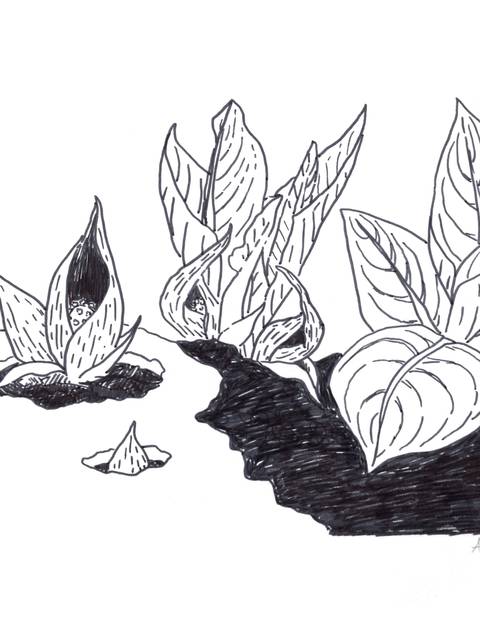
Scientific Name: Symplocarpus foetidus
Family Name: Araceae
The Skunk Cabbage is often called the first flower of spring. This is because the Skunk Cabbage utilizes biochemical reactions to heat itself to 60 degrees Fahrenheit. This allows it to melt its way through snow cover before most other plants. The plant emits a strong decaying odor that it uses to lure insects for pollination. This putrid odor is how the plant gets its name. The inflorescence (cluster of flowers) appears before the leaves. The spathe is a large modified leaf enclosing the flower cluster. The spathe is brownish-purple and green mottled in color. The spathe surrounds the spadix which is covered in tiny flowers and appears knob like. In late spring, large dark green cabbage-like leaves sprout and carpet the area. Skunk cabbage is found in marshy woodlands of the eastern United States and into Canada.
Learn more about the Skunk Cabbage on Consortium of Midwest Herbaria.
Virginia Spring Beauty
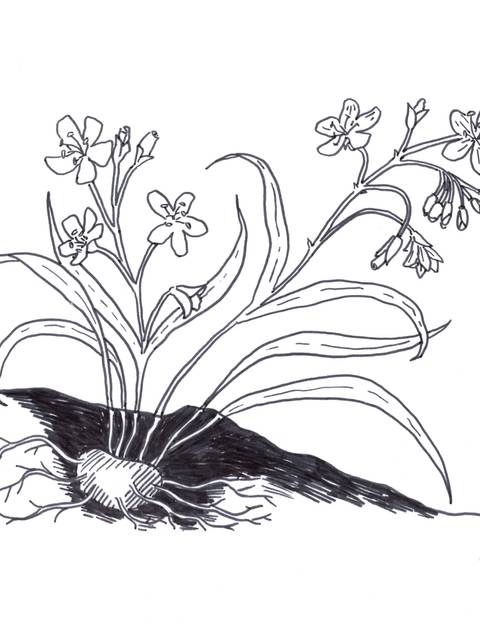
Scientific Name: Claytonia virginica
Family Name: Portulacaceae
The Virginia Spring Beauty is a part of the Purslane family (Portulacaceae). The plant is characterized as a low plant, growing 4-12 inches high, with clusters of pink or whitish flowers, striped with dark pink. The leaves of the plant are narrow and appear grass-like. An early bloomer, look for flowers from this perennial in April and early May. The plant enjoys rich moist soils and is visited by a large number of native bees when flowering. The plant grows from an underground tuber, like a small potato, that is edible and was used by Indigenous People and early colonists as food. Prevalent in the mountains of the eastern United States, this plant also grows across Wisconsin and into Minnesota.
Learn more about the Virginia Spring Beauty on Consortium of Midwest Herbaria.
Wild Geranium
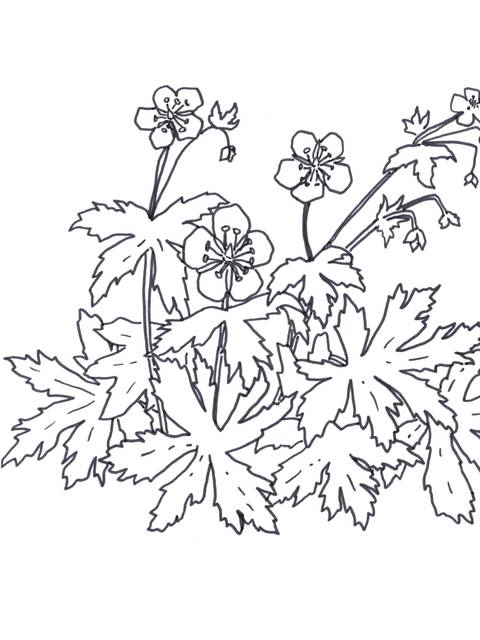
Scientific Name: Geranium maculatum
Family Name: Geraniaceae
As the name implies, wild geranium is part of the geranium family (Geraniaceae). Wild geranium produces showy, pink, five-petaled flowers that occur at the top of leafy 1-3 inch stems in May into June. Pink flowers are found in loose clusters of 2-5 at the ends of stems above a pair of deeply 5-lobed leaves, the plant grows to be around 12-28 inches tall. This plant colonizes by rhizomes (a horizontal underground stem which new shoots branch out of at regular intervals) causing colonies to form. Wild geranium is found in woodlands of the Midwest and Northeast United States.
Learn more about the Wild Geranium on Consortium of Midwest Herbaria.
Wild Oats
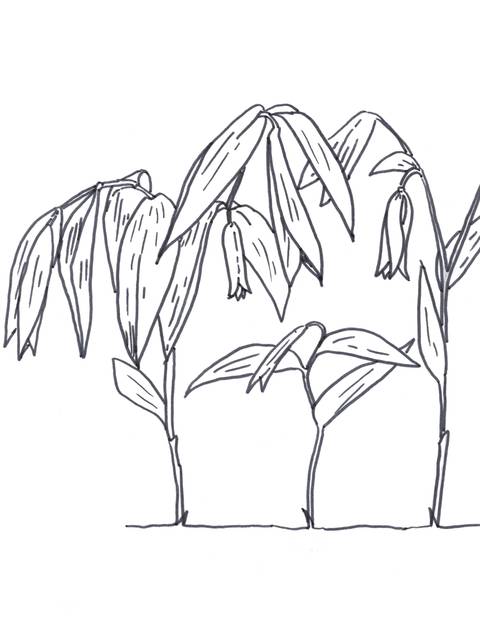
Scientific Name: Uvularia sessilifolia
Family Name: Colchicaceae
Wild Oats is a small 10-15 inch perennial that is found across Wisconsin in woodlands. It is also sometimes referred to as spreading bellwort, straw lily, merrybells and sessile bellwort. The stalks of this plant are usually two-branched and bear oval lily-like leaves. Delicate cream-colored flowers 1 inch long may be single or paired and hang like bells on short stems. Wild Oats were formerly in the Lily family but now have been reassigned to the Autumn-crocus family. The plant shares many similarities with the lily family such as showy flowers divided into 6 parts, parallel venation, and living part of their life cycle as a bulb or rhizome.
Learn more about Wild Oats on Consortium of Midwest Herbaria.
About Putnam Park
Putnam Park is a 230-acre natural area that arcs through residential neighborhoods in the City of Eau Claire as well as UW-Eau Claire's lower campus. It is characterized by its predominantly forested land. Stretching in a long, curving, narrow strip, the park showcases a diverse range of flora and fauna, including a plant species that is considered threatened in the state. The forest within the park consists of both southern wet-mesic and northern dry-mesic varieties.
The dry-mesic forest in Putnam Park is notable for its impressive white and red pine trees, which dominate the landscape. On the other hand, the wet-mesic forest is primarily comprised of river birch, silver maple, hackberry, red maple, and paper birch. In the wettest sections, particularly at the eastern end of the park, occasional tamarack and white cedar can be found.
What makes Putnam Park particularly remarkable is its diverse topography, which encompasses bedrock exposures, seepage springs, and various soil types in close proximity. These factors contribute to the creation of numerous habitats for both plant and animal species. Over 400 species of plants, 100 species of birds during the summer, and 23 mammal species have been documented within the park.
The initial portion of the park's land was generously donated to the City of Eau Claire in 1909 by Henry C. Putnam. Mr. Putnam's intention was to preserve the land in its natural state and establish it as a perpetual botanical laboratory and park.
Over time, additional parcels of land have been acquired and incorporated into the original donated tract. In 1957, ownership of the park was transferred from the city to the university. Presently, approximately half of Putnam Park holds the designation of a Wisconsin State Natural Area, a designation made in 1976, highlighting its significance in terms of conservation and preservation.